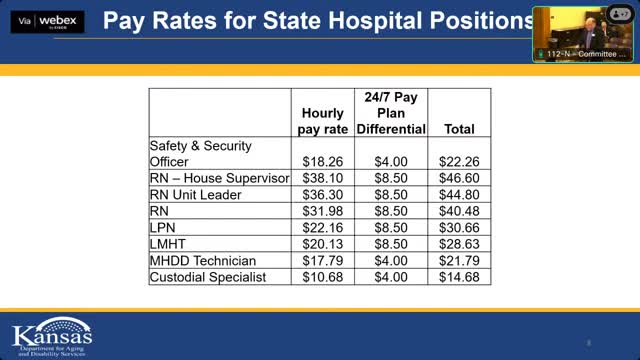State hospitals face critical staffing shortages with RN vacancy rates exceeding 65 percent
January 08, 2025 | Special Committee on State Employee Compensation, Special & Select, Committees, Legislative, Kansas
This article was created by AI summarizing key points discussed. AI makes mistakes, so for full details and context, please refer to the video of the full meeting. Please report any errors so we can fix them. Report an error »

In a recent meeting of the Special Committee on State Employee Compensation in Kansas, the pressing issue of employee pay and vacancy rates within state hospitals took center stage. As the discussion unfolded, committee members were presented with a detailed overview of current pay rates for critical positions, revealing a stark picture of staffing challenges that could impact patient care.
The meeting highlighted that a newly graduated registered nurse starts at $40.48 per hour, while mental health direct care staff, known as MHDD technicians, earn $21.79 per hour. In a notable effort to improve wages, custodial specialists now earn a minimum of $15.03 per hour, reflecting a broader initiative to ensure all state employees receive at least this wage.
However, the most alarming aspect of the meeting was the vacancy rates for essential roles. The committee learned that the registered nurse vacancy rate stands at a staggering 65.8%, with temporary staff filling the gaps. The situation is similarly dire for MHDD technicians, who face a vacancy rate of 46.9%. These figures indicate a critical shortage of staff necessary for the daily operations of state hospitals, raising concerns about the quality of care provided to patients.
The discussion also included a breakdown of vacancies across various state hospitals. For instance, Osuwatomie reported a 52.9% vacancy rate, while Parsons State Hospital saw an increase in vacancies from 41 to 74 over the past year. This trend underscores the ongoing struggle to maintain adequate staffing levels, which is essential for effective healthcare delivery.
As the committee reviewed charts illustrating these trends, it became clear that the state must address these staffing shortages urgently. With a manageable vacancy rate targeted at around 30%, the reliance on temporary and agency staff is becoming increasingly unsustainable. The implications of these vacancies extend beyond mere numbers; they pose a significant risk to the health and safety of those relying on state healthcare services.
The meeting concluded with a call to action, emphasizing the need for a comprehensive strategy to enhance employee compensation and attract new talent to the state’s healthcare system. As the committee continues its work, the urgency of these discussions will likely shape the future of state employee compensation and the quality of care provided to Kansas residents.
The meeting highlighted that a newly graduated registered nurse starts at $40.48 per hour, while mental health direct care staff, known as MHDD technicians, earn $21.79 per hour. In a notable effort to improve wages, custodial specialists now earn a minimum of $15.03 per hour, reflecting a broader initiative to ensure all state employees receive at least this wage.
However, the most alarming aspect of the meeting was the vacancy rates for essential roles. The committee learned that the registered nurse vacancy rate stands at a staggering 65.8%, with temporary staff filling the gaps. The situation is similarly dire for MHDD technicians, who face a vacancy rate of 46.9%. These figures indicate a critical shortage of staff necessary for the daily operations of state hospitals, raising concerns about the quality of care provided to patients.
The discussion also included a breakdown of vacancies across various state hospitals. For instance, Osuwatomie reported a 52.9% vacancy rate, while Parsons State Hospital saw an increase in vacancies from 41 to 74 over the past year. This trend underscores the ongoing struggle to maintain adequate staffing levels, which is essential for effective healthcare delivery.
As the committee reviewed charts illustrating these trends, it became clear that the state must address these staffing shortages urgently. With a manageable vacancy rate targeted at around 30%, the reliance on temporary and agency staff is becoming increasingly unsustainable. The implications of these vacancies extend beyond mere numbers; they pose a significant risk to the health and safety of those relying on state healthcare services.
The meeting concluded with a call to action, emphasizing the need for a comprehensive strategy to enhance employee compensation and attract new talent to the state’s healthcare system. As the committee continues its work, the urgency of these discussions will likely shape the future of state employee compensation and the quality of care provided to Kansas residents.
View full meeting
This article is based on a recent meeting—watch the full video and explore the complete transcript for deeper insights into the discussion.
View full meeting
